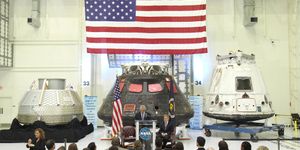The Airbus A380 is currently the largest passenger plane in the sky. In fact, with a capacity of 530 passengers, it is the largest airliner ever built. But a revolutionary new design for passenger aircraft would dwarf the A380. The concept is called The AWWA Sky Whale.

The Sky Whale is the brainchild of Spanish designer Oscar Vinals. Able to carry 755 passengers, it would be bigger than current planes, yes, but in several crucial ways it would also be better.
"Travelling in the Sky Whale could be like a travelling in your private ‘theatre seat', enjoying what happens around you; hearing some air flow noise, but feeling safe inside a big and intelligent structure," Vinals says. The design would incorporate a number of advanced technologies including a transparent roof, and possibly replacing most of the other windows with giant led screens that could project the environment outside the plane, or switch to a passenger's choice of entertainment. It would also include self-repairing wings made out of a ceramic composite material, swiveling engines to enable a near vertical take-off. This would allow the Sky Whale to use much shorter runways than current airliners.
The Sky Whale would also employ hybrid, electric/ jet fuel propulsion. Like a hybrid car, the Sky Whale would be powered in part by batteries, which would run electric motors. "The engines and batteries are fed by a turbine inside the wings, like a high-speed and powerful dynamo," Vinals explains.
The design would also use a system to redirect airflow to intake engines and to control laminar flow. The goal there would be to reduce turbulence around the plane and reduce drag. This would not only make the design highly efficient, it would make it far quieter than current jet liners.
"None of these technologies are feasible on a large scale at the moment," says Vinals, "but all are possible. ... I did this because I am an aerospace and aviation enthusiast - the technology, development and evolution," explains Vinals. "I would like to contribute, with my vision, about these."
"I think that's where these concepts come in," says Dr. Michael Jump. He's a lecturer in aerospace engineering at the University of Liverpool. "It's people challenging through their imaginations."
According to Jump there are three factors to consider when evaluating the design of an aircraft, collectively known as the Breguet Range equation.
The first is propulsive efficiency (the efficiency of the engines); the second is aerodynamic efficiency (this means is lift maximized and drag minimized?); the third is structural efficiency (given the configuration, how much payload in cargo or passengers, or both can it carry?).
Essentially the goal of all airlines is to fly as far as possible, with the biggest load (or largest combined weight of passengers) possible, using the smallest amount of fuel possible. Being able to increase all three, means you have come up with a better aircraft design.
Obviously a departure in design from the current standard will meet with resistance. "The likes of Boeing and Airbus have a lot of experience of building aircraft that look like a tube and two wings," Jump explains. And, in their defense, a cylinder is a structurally efficient way to contain pressure, which is obviously vital for any airliner that flies at high altitude.
"Airplanes look the way they do, not because of some stylistic decision, but almost entirely for technical reasons," explains Mark Drela, a professor in the department of aeronautics and astronautics at MIT. "Form follows function." He is, therefore dubious of the viability of the Sky Whale design.
Another consideration of course is demonstrated safety. A radical new design like the Sky Whale would be much harder to test and certify. The Whale does, however incorporate one revolutionary safety innovation: in a crash, the fuselage would separate from the wings, to protect the passengers, similar to the crumple zones on a car.
Even with resistance from the airline industry and some scientists alike, Vinals remains optimistic, quoting Albert Einstein: "Your imagination is your preview of life's coming attractions".
(Source: BBC)









